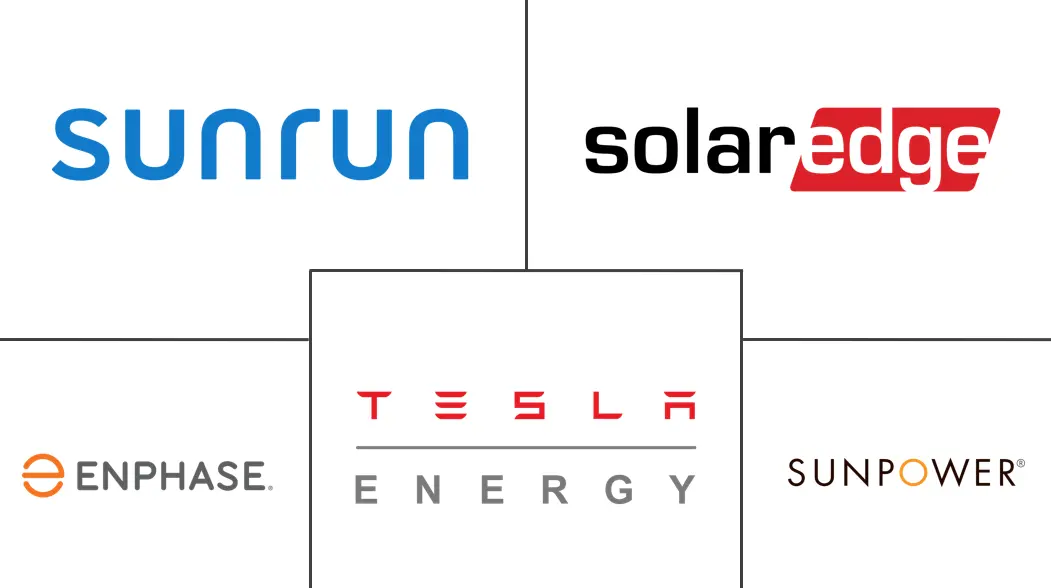Residential Solar Energy Market Size and Share
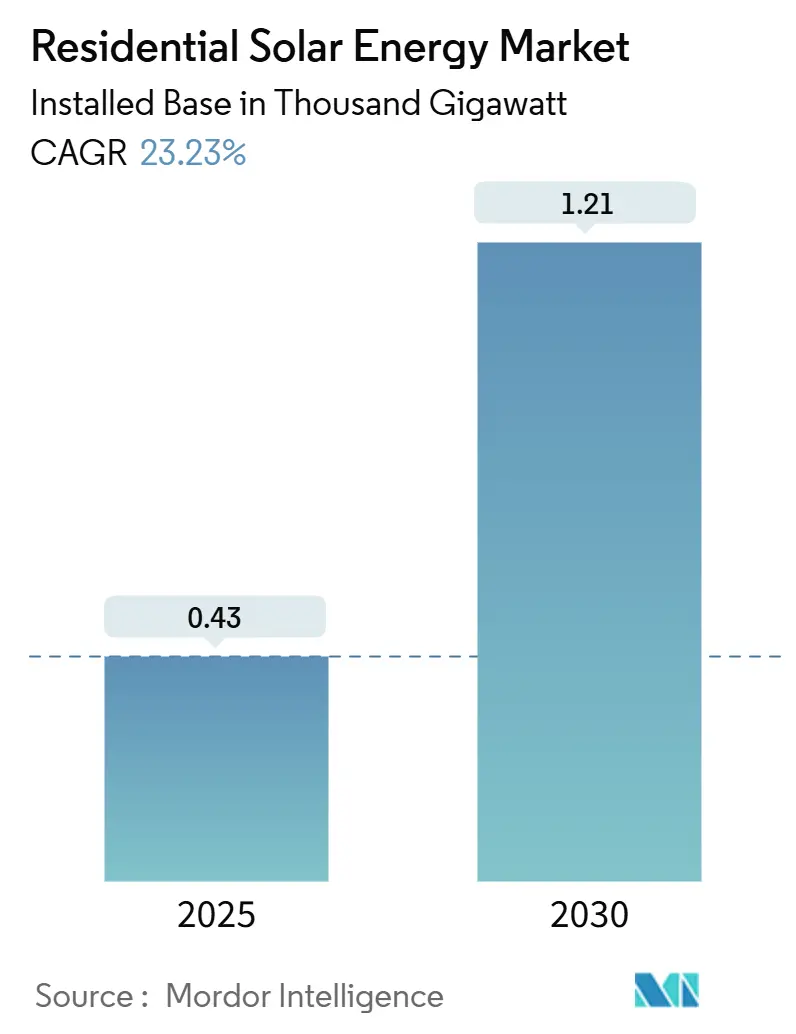
Residential Solar Energy Market Analysis by Mordor Intelligence
The Residential Solar Energy Market size in terms of installed base is expected to grow from 0.43 Thousand gigawatt in 2025 to 1.21 Thousand gigawatt by 2030, at a CAGR of 23.23% during the forecast period (2025-2030).
Growth momentum is driven by declining technology costs, supportive policy incentives, and households seeking energy security. N-type TOPCon cells have reached laboratory efficiencies of 33.24%, making residential systems cost-competitive with retail electricity across many regions. Financing innovation, especially securitized solar loans, continues to lower capital costs, while smart-home ecosystems that bundle rooftop solar with storage and electric-vehicle (EV) charging broaden the addressable customer base. Although interest-rate spikes and policy uncertainty around tax credits create near-term headwinds, the fundamental economics of residential self-generation remain favorable, underpinning steady adoption of rooftop solar across all major markets.
Key Report Takeaways
- By technology, monocrystalline PERC retained 84% of the residential solar energy market share in 2024; N-type TOPCon is poised for the fastest expansion at a 25.0% CAGR to 2030.
- By installation type, conventional rooftop arrays held 95% of the residential solar energy market size in 2024, while building-integrated solar roof tiles will advance at a 26.0% CAGR through 2030.
- By grid type, on-grid systems commanded 78% of the residential solar energy market share in 2024, whereas hybrid PV-plus-storage systems are forecast to climb at a 27.0% CAGR to 2030.
- By geography, North America led with 35% revenue share in 2024; Asia-Pacific is projected to log the fastest 30.0% CAGR through 2030.
- Sunrun, Tesla Energy, and three other top installers together accounted for 42% of the residential solar energy market size in 2024, reflecting a moderate level of consolidation.
Global Residential Solar Energy Market Trends and Insights
Drivers Impact Analysis
| Driver | (~) % Impact on CAGR Forecast | Geographic Relevance | Impact Timeline |
|---|---|---|---|
| Declining module & BOS costs | 4.2% | Global | Long term (≥ 4 years) |
| Inflation Reduction Act-style incentive waves spreading beyond the US | 3.8% | North America & EU, spill-over to APAC | Medium term (2-4 years) |
| Spike in retail power prices & grid-outage anxiety | 3.1% | Global, with early gains in California, Texas, Germany | Short term (≤ 2 years) |
| EV-charger-ready home energy ecosystems | 2.9% | APAC core, spill-over to North America | Long term (≥ 4 years) |
| Maturing residential solar loan securitization platforms | 2.4% | North America core, expanding to Australia, UK | Medium term (2-4 years) |
| Peer-to-peer blockchain energy trading pilots | 1.1% | National, with early gains in Arizona, Austria, Japan | Long term (≥ 4 years) |
| Source: Mordor Intelligence | |||
Declining Module & BOS Costs
Module prices slid below USD 0.20 per W in 2024 and are tracking toward USD 0.15 per W by 2027, anchored by China’s ongoing factory expansions that unlock economies of scale. Coupled with 26.5% production efficiencies now possible in N-type TOPCon lines, higher-power modules shrink array footprints and reduce mounting hardware and labor needs. Inverter unit costs fell another 15% last year, while standardized wiring kits trimmed soft costs. The aggregate impact lowers the levelized cost of electricity beneath residential tariffs that apply to more than 60% of global households, turning rooftop solar from a premium add-on into a mainstream household appliance. Elevated efficiency also prolongs roof-space relevance, a critical advantage for urban homes with limited surface area. JinkoSolar’s 56 GW Shanxi facility underscores how large-scale manufacturing continues to compress prices.[1]PV Magazine, “JinkoSolar Breaks Ground on 56 GW Module Factory in Shanxi,” pv-magazine.com
IRA-Style Incentive Waves Spreading Beyond the US
The United States’ 30% federal investment tax credit catalyzed parallel programs worldwide. Europe’s REPowerEU earmarked EUR 210 billion for renewables, while Germany re-introduced feed-in tariffs and scrapped VAT on solar hardware to jump-start rooftop adoption. Japan now offers JPY 70,000 per kW for storage-paired arrays, and Australia’s Victoria Solar Homes rebate provides AUD 1,400 per household. Policymakers structure these incentives to phase down in tandem with falling equipment costs, borrowing the US blueprint of gradually converting subsidies into market-based economics. The synchronized policy wave accelerates installation volumes today and creates future headroom for unsubsidized growth once parity is achieved. As incentives spread, installers enter new regions with proven finance and supply-chain models, reinforcing scale benefits that feed back into cost decline.
Spike in Retail Power Prices & Grid-Outage Anxiety
Residential power tariffs have climbed 25% since 2022, exceeding USD 0.50 kWh in certain Californian time-of-use windows. High volatility, amplified by gas price swings and grid-upgrade surcharges, bolsters homeowner demand for cost control. Concurrently, weather-related outages—Texas’ 4.2 million customer black-out in 2024 and rolling brownouts in Germany—elevate the perceived value of self-generation with backup storage. Surveys show 73% of solar buyers rank energy security above payback period, marking a behavioral shift from purely economic drivers toward resilience planning. Net-metering reforms that reduce export credits further incentivize onsite consumption, nudging households to add batteries that smooth demand peaks. Collectively, pricing pain and outage fatigue prime the residential solar energy market for hybrid systems emphasizing self-sufficiency.
EV-Charger-Ready Home Energy Ecosystems
Residential solar arrays increasingly anchor integrated energy hubs that bundle bidirectional EV chargers, smart inverters, and batteries. Enphase’s acquisition of ClipperCreek fast-tracked its entry into bidirectional charging, while Tesla and Eaton collaborate on unified power management suites. Vehicle-to-home functionality lets EVs like Ford’s F-150 Lightning feed 131 kWh back to a house for multi-day backup, turning car batteries into grid-edge assets. Regulatory pilots in California reward such flexibility with frequency-regulation payments, adding a revenue layer atop bill savings. This convergence of transport and electricity widens the target market beyond traditional solar adopters to EV owners seeking holistic energy solutions, supporting longer-term demand for high-capacity rooftop systems and premium inverters.
Restraints Impact Analysis
| Restraint | (~) % Impact on CAGR Forecast | Geographic Relevance | Impact Timeline |
|---|---|---|---|
| Volatile interest-rate environment inflating customer acquisition costs | -2.8% | Global, with acute impact in North America & EU | Short term (≤ 2 years) |
| Sudden net-metering policy roll-backs (e.g., CA NEM 3.0) | -2.1% | North America core, emerging in Australia, Germany | Medium term (2-4 years) |
| Installer labour & permitting bottlenecks in key metros | -1.9% | North America & EU, with acute shortages in California, Texas, Germany | Long term (≥ 4 years) |
| Polysilicon-supply ESG scrutiny limiting premium-segment demand | -1.4% | Global, with supply chain concentrated in China | Medium term (2-4 years) |
| Source: Mordor Intelligence | |||
Volatile Interest-Rate Environment Inflating Customer Acquisition Costs
Rapid monetary tightening lifted 30-year solar-loan coupons from 4.5% in 2022 to 7.8% in 2024, eroding the consumer value proposition for financed systems. Lenders responded by raising down-payment thresholds, tightening credit filters, lengthening sales cycles, and pushing customer acquisition costs up 35%. Market segments reliant on long-tenor loans, including many first-time buyers, deferred purchases, especially in regions where electricity tariffs are moderate. Larger installers secure lower rates via securitizations, but smaller contractors lack similar funding breadth, narrowing competitive diversity. Until rate volatility subsides, cash sales and leases regain temporary attractiveness, altering product mixes and stressing dealer working capital.
Sudden Net-Metering Policy Roll-Backs
California’s NEM 3.0 reduced export credits by 75%, extending payback periods from 7 years to beyond 12 years for export-heavy systems. Illinois adopted a similar stance in January 2025, and several Australian states signaled parallel reviews. Such abrupt revisions create planning uncertainty for installers, financiers, and component suppliers. Consumers react by coupling batteries to maximize self-consumption—California’s storage attachment rate jumped from 15% to 65% within 12 months. Yet higher upfront costs slow overall volume growth, undercutting economies of scale that keep equipment prices falling. Thus, Policy reversals drag the otherwise robust residential solar energy market trajectory.
Segment Analysis
By Technology: N-Type Transition Accelerates Premium Adoption
Monocrystalline PERC modules dominated the residential solar energy market share with 84% in 2024, but N-type TOPCon shipments are forecast to post a 25.0% CAGR through 2030 as efficiency gains translate into higher roof-level energy density. This shift broadens the residential solar energy market size for premium-priced products that add generation without expanding the array footprint.
Manufacturers pivot to TOPCon to defend margins in an increasingly commoditized PERC landscape. Unit-cost convergence—helped by higher throughput and better wafer yields—allows TOPCon to approach PERC pricing while adding 1-2 percentage points of efficiency to shorten payback periods materially in space-constrained urban dwellings. JinkoSolar’s record 33.24% perovskite-tandem result underscores the pathway to future gains and solidifies TOPCon as the mainstream platform for next-generation cell architectures.[2]JinkoSolar, “2024 Annual Report,” jinkosolar.com While thin-film and polycrystalline alternatives persist in niche roles, TOPCon now anchors the premium tier and guides long-run R&D roadmaps for module makers.
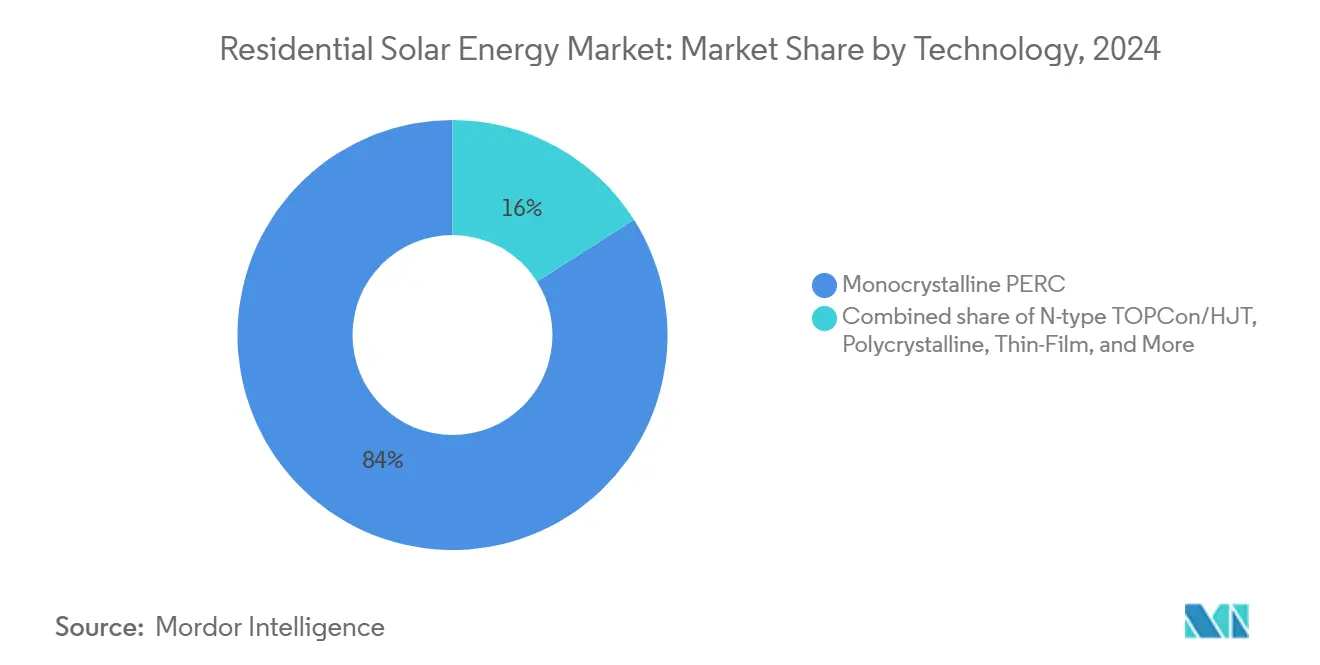
Note: Segment shares of all individual segments available upon report purchase
By Installation Type: BIPV Emerges as Architectural Integration Driver
Rooftop-mounted arrays controlled 95% of the residential solar energy market size in 2024, yet building-integrated photovoltaics (BIPV) will expand at a 26.0% CAGR to 2030 as aesthetics and green-building mandates propel demand. New-home builders increasingly pre-install solar tiles that double as weatherproof roofing, sidestepping post-construction permitting and visual objections common in heritage districts.
Third-generation BIPV shingles now achieve cost parity with premium roofing plus panels, shifting the value conversation from payback to curb appeal and resale price. Municipalities that link occupancy permits to net-zero standards further accelerate BIPV uptake, especially where rooftop geometry limits conventional rack-mount angles. The architectural integration trend, therefore, enlarges the residential solar energy market by appealing to design-conscious homeowners previously reluctant to add visible panels.
By Grid Type: Hybrid Systems Capture Storage Value Premium
On-grid arrays still lead with 78% of the residential solar energy market share in 2024, but hybrid PV-plus-storage configurations are advancing at 27.0% CAGR as time-of-use tariffs reward load shifting. California’s NEM 3.0 slashed export rates, prompting a surge in battery attachments that re-aligned system economics around self-consumption.
Microinverter-battery packages delivered by Enphase and Tesla simplify installation, letting contractors commission a complete hybrid stack within a single site visit. Virtual power-plant enrollments add monetization channels by aggregating household batteries into grid-service fleets, generating revenue that trims payback by 1-2 years. The dual benefit of bill savings and resilience cements hybrid status as the preferred choice in policy environments where export compensation is under review, enlarging the residential solar energy market size for storage vendors and inverters.
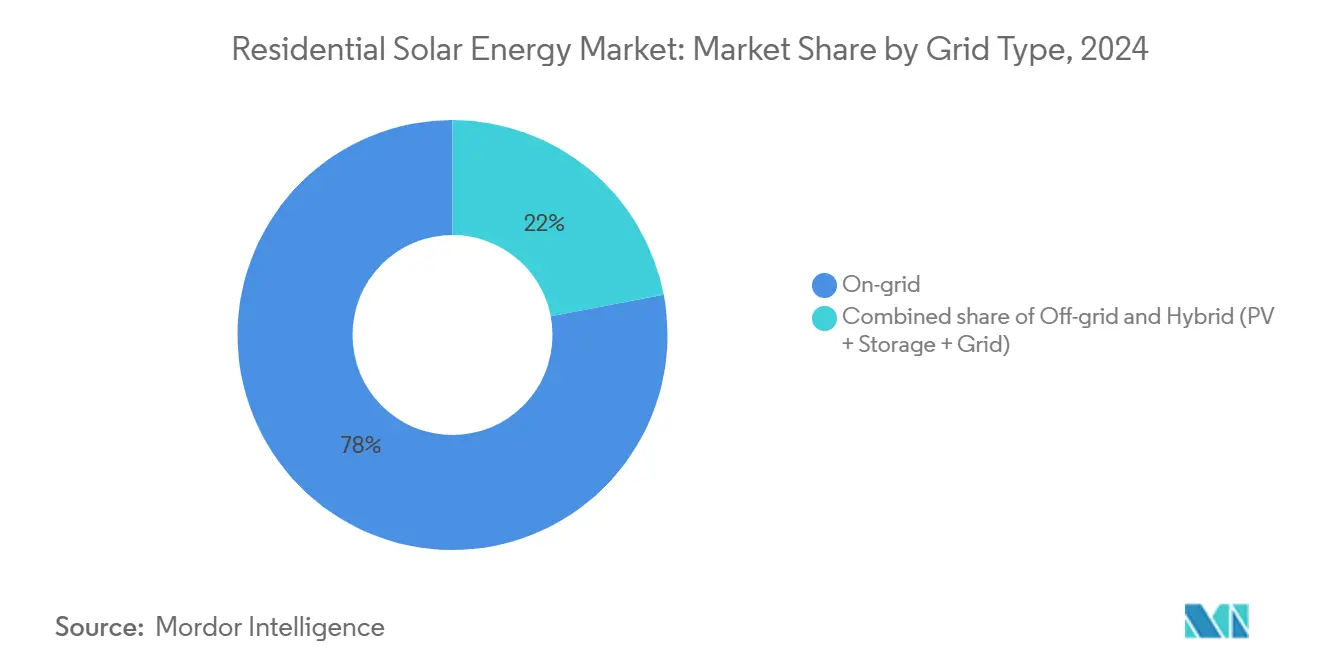
Note: Segment shares of all individual segments available upon report purchase
Geography Analysis
North America retained 35% of the global residential solar energy market revenue in 2024, buoyed by sophisticated financing and mature installer networks. Last year, securing loan vehicles totaling over USD 3 billion signaled institutional faith in rooftop cash-flows. Even so, the pending elimination of the federal tax credit and spreading net-metering reforms create strategic urgency for households to install before incentives lapse, sustaining near-term volume despite policy uncertainty.
Asia-Pacific is projected to deliver the fastest 30.0% CAGR, expanding the regional residential solar energy market size through rapid urbanization, rising electricity tariffs, and proactive decarbonization goals. China capitalizes on domestic manufacturing dominance to deploy high-density arrays in tier-one cities, while India’s streamlined interconnection rules open residential segments previously hindered by bureaucracy. Japan emphasizes storage-paired rooftops to bolster earthquake resilience, subsidizing hybrid systems that promise backup power during grid interruptions.
Europe’s outlook remains resilient as REPowerEU funds cascade into member-state programs that remove VAT and fine-tune feed-in tariffs. Germany’s policy reset revived household demand, and Spain’s abundant irradiation pairs with regulatory stability to sustain installations. Nordic countries, facing winter irradiance dips, are early adopters of seasonal storage solutions. Across the bloc, traceability mandates elevate suppliers able to verify non-Xinjiang polysilicon sourcing, shaping procurement decisions and nudging the residential solar energy industry toward diversified supply chains.
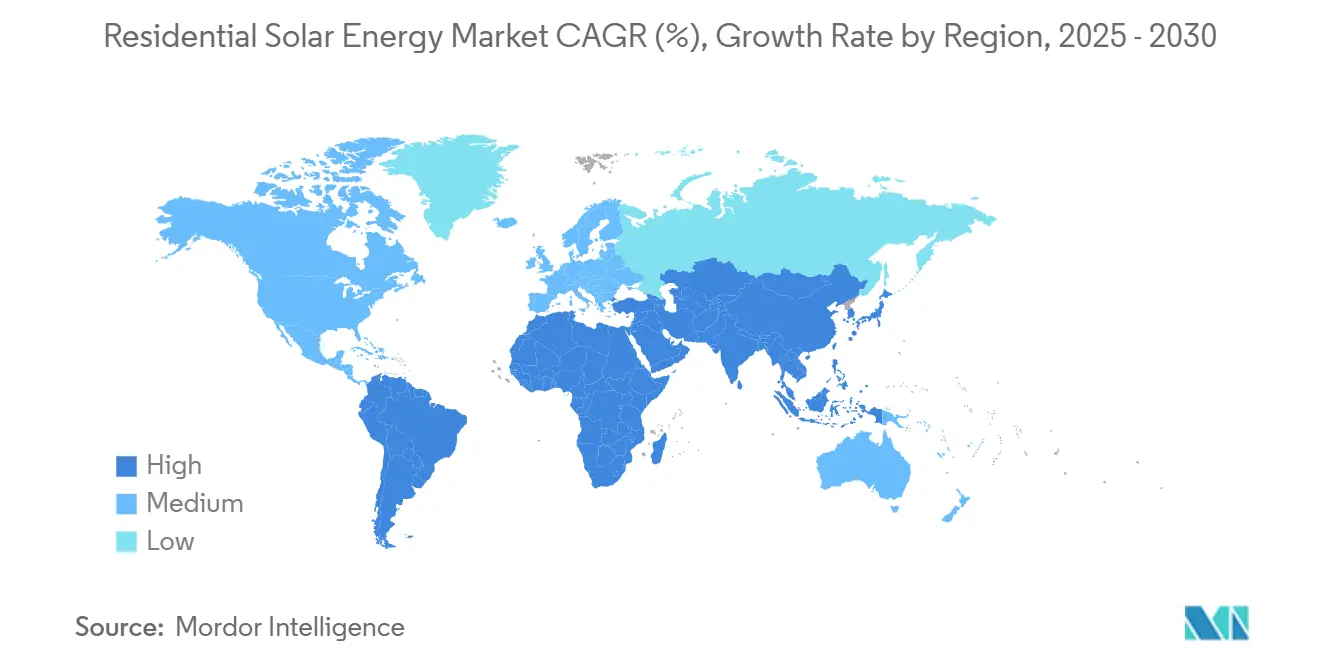
Competitive Landscape
Market share is consolidating around a handful of scale players integrating installation, finance, and after-sales service. Sunrun, Tesla Energy, Enphase-backed installers, and two regional specialists captured 42% of 2024 installations. Vertical integration affords them bulk purchasing, lower borrowing costs, and strong brand recognition, enabling sub-USD3 W turnkey pricing in core markets. Sunrun’s USD 1.6 billion dual securitizations exemplify the capital leverage available at scale, while SunPower’s bankruptcy and takeover by Complete Solar underline the margin pressure faced by mid-tier players.[3]Solar Power World, “First Solar Sues JinkoSolar Over TOPCon Patents,” solarpowerworldonline.com
Technology leadership is an emerging battleground. Patent litigation—such as First Solar’s infringement claims against JinkoSolar over TOPCon—highlights the strategic weight of intellectual property in an arena where module commoditization squeezes margins. Installers differentiate with integrated software that optimizes generation, storage, and EV charging, tilting competition toward holistic energy-as-a-service propositions rather than stand-alone panel sales.
Regional challengers harness local knowledge and nimble operations to win in secondary markets, often focusing on rural customers or community microgrids overlooked by national brands. Digital-first newcomers apply predictive analytics to shorten site assessments and automate permitting, trimming soft costs. While no single company dominates outright, the barriers to entry are rising as scale, technology, and financing become intertwined in capturing the growing residential solar energy market.
Residential Solar Energy Industry Leaders
Sunrun Inc.
Tesla Energy
Enphase Energy
SunPower Corporation
SolarEdge Technologies
- *Disclaimer: Major Players sorted in no particular order
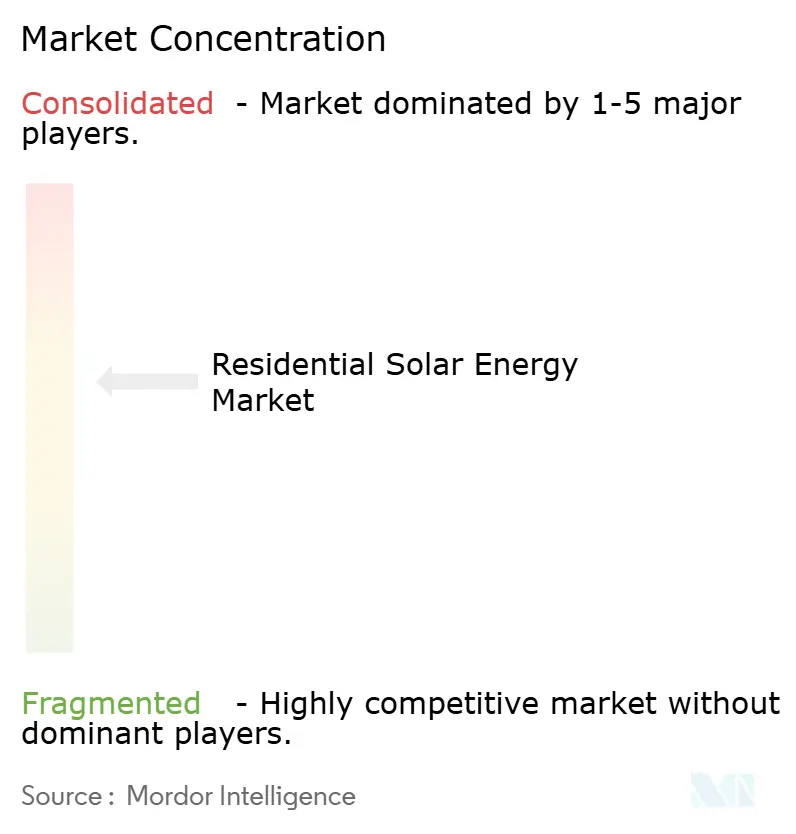
Recent Industry Developments
- July 2025: Congress voted to eliminate the 30% residential ITC, awaiting presidential signature and accelerating pre-sunset installation demand.
- May 2025: JinkoSolar achieved 33.24% conversion efficiency with a perovskite-tandem TOPCon cell, setting a new laboratory record.
- March 2025: JinkoSolar shipped 92.9 GW of modules in 2024, 90% of which were N-type TOPCon, reinforcing its global volume lead.
- February 2025: First Solar filed patent infringement suits against JinkoSolar covering TOPCon architectures.
Global Residential Solar Energy Market Report Scope
Residential solar PV consists of photovoltaic cells and is nonchemical technology that turns sunlight into energy to power household appliances and equipment. It is a rapidly growing renewable energy technology and plays a vital role in global energy transformation.
The residential solar energy market is segmented by geography. The report also covers the market size and forecasts across major regions. For each segment, the market sizing and forecasts have been done based on installed capacity (GW).
| Monocrystalline PERC |
| N-type TOPCon/HJT |
| Polycrystalline |
| Thin-film (CdTe, CIGS) |
| Emerging Perovskite Tandems |
| Rooftop-mounted PV |
| Building-integrated solar roof tiles |
| On-grid |
| Off-grid |
| Hybrid (PV + Storage + Grid) |
| North America | United States |
| Canada | |
| Mexico | |
| Europe | United Kingdom |
| Germany | |
| France | |
| Spain | |
| Nordic Countries | |
| Russia | |
| Rest of Europe | |
| Asia-Pacific | China |
| India | |
| Japan | |
| South Korea | |
| Malaysia | |
| Thailand | |
| Indonesia | |
| Vietnam | |
| Australia | |
| Rest of Asia-Pacific | |
| South America | Brazil |
| Argentina | |
| Colombia | |
| Rest of South America | |
| Middle East and Africa | United Arab Emirates |
| Saudi Arabia | |
| South Africa | |
| Egypt | |
| Rest of Middle East and Africa |
| By Technology | Monocrystalline PERC | |
| N-type TOPCon/HJT | ||
| Polycrystalline | ||
| Thin-film (CdTe, CIGS) | ||
| Emerging Perovskite Tandems | ||
| By Installation Type | Rooftop-mounted PV | |
| Building-integrated solar roof tiles | ||
| By Grid Type | On-grid | |
| Off-grid | ||
| Hybrid (PV + Storage + Grid) | ||
| By Geography | North America | United States |
| Canada | ||
| Mexico | ||
| Europe | United Kingdom | |
| Germany | ||
| France | ||
| Spain | ||
| Nordic Countries | ||
| Russia | ||
| Rest of Europe | ||
| Asia-Pacific | China | |
| India | ||
| Japan | ||
| South Korea | ||
| Malaysia | ||
| Thailand | ||
| Indonesia | ||
| Vietnam | ||
| Australia | ||
| Rest of Asia-Pacific | ||
| South America | Brazil | |
| Argentina | ||
| Colombia | ||
| Rest of South America | ||
| Middle East and Africa | United Arab Emirates | |
| Saudi Arabia | ||
| South Africa | ||
| Egypt | ||
| Rest of Middle East and Africa | ||
Key Questions Answered in the Report
What is the expected growth rate of the residential solar energy market to 2030?
The residential solar energy market is forecast to expand from 427.17 GW in 2025 to 1,213.90 GW in 2030, reflecting a 23.23% CAGR.
Which region leads the residential solar energy market?
North America held the largest 35% share in 2024, driven by mature financing structures and state-level incentives.
Why is N-type TOPCon technology gaining traction?
TOPCon offers 1-2 percentage-points higher efficiency than PERC at near-parity manufacturing cost, shortening payback times for space-constrained rooftops.
How will eliminating the US federal tax credit affect adoption?
Short-term demand is expected to spike as homeowners rush to complete projects before the credit sunsets, followed by a moderate slowdown as incentives phase out.
What role do batteries play in future rooftop systems?
Hybrid PV-plus-storage configurations are forecast to grow at 27.0% CAGR because they maximize self-consumption amid declining net-metering rates and enhance energy security during outages.
Are building-integrated solar tiles cost-competitive with traditional panels?
In premium housing segments, third-generation BIPV tiles now price on par with high-end roofing plus separate solar arrays, making aesthetics-driven adoption viable.
